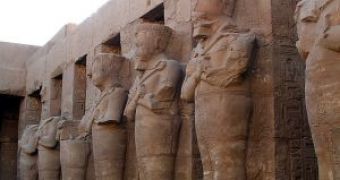Karnak temple (Ipet Sut in Ancient Egyptian "the most venerated place") is a vast open-air museum and the largest ancient religious site in the world, in Egypt being surpassed in the number of visitors only by the Giza Pyramids near Cairo. The temple is dedicated to Amun-Re, the most important Old Egyptian God.
Karnak Temple is situated on the banks of the River Nile some 2.5 km (1.5 mile) north of Luxor. Of its four main parts, only one is accessible to tourists. This is also the "main" temple part and by far the largest one.
Karnak set off compared to other Egyptian temples by the length of time over which it was developed and used. Its construction began in the 16th century BC and about 30 pharaohs contributed to the buildings, enabling it to reach a size, complexity and diversity not seen elsewhere. Recently, Egypt has announced the discovery of a carving dating back to the 12th century BC which could hold the key to valuable information on Karnak temple. The large quartzite stone, carved with 17 lines of hieroglyphics, highlights the achievements of high priest Bak En Khonso and his contributions to the grand hall at Karnak.
The 170 cm by 80 cm carving (5.5 by 2.5 feet), dug by a team of Egyptian archaeologists in the southern Nile city of Luxor, also depicts the high priest's family tree. "This is very important because we never knew anything about Bak En Khonso, the second most important man after the pharaoh", said Zahi Hawass, head of Egypt's Supreme Council of Antiquities. "This is going to reconstruct history and will enrich our understanding of Karnak," said Hawass.
Bak En Khonso lived during the reign of King Setnakhte, which founded Egypt's Twentieth Dynasty. A high priest was the second person in the state after the pharaoh, performing duties, religious rituals and offerings on his behalf. "There are still so many treasures underground," said Hawass, who thinks that 70 % of Egypt's antiquities are yet to be found.

 14 DAY TRIAL //
14 DAY TRIAL //